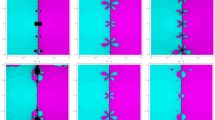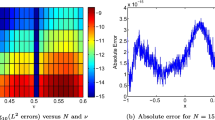Abstract
A special class of Runge-Kutta(-Nyström) methods called functionally fitted (or functional fitting) Runge-Kutta (FRK) methods has recently been proposed by the author. This class of methods is designed to be exact, if the solution of the equation to be solved is an element of the linear space of given functions, which is called the basis functions. The purpose of this article is to develop a functionally fitted Runge-Kutta method that is cheap to implement. The method proposed in this paper is a three-stage explicit singly diagonally implicit Runge-Kutta (ESDIRK) method, which requires oneLU decomposition per step. This method is exact if the basis functions are properly chosen, and is moderately accurate even if the choice of the functions is inappropriate, since the method is shown to be of order 4 for general cases. An embedded pair of this type is also developed. Several numerical experiments show the superiority of the methods to conventional ones for the particular case that a suitable set of the basis functions can be found.
Similar content being viewed by others
References
J. Butcher, Numerical Methods for Ordinary Differential Equations. Wiley, 2003.
J.P. Coleman, Mixed interpolation methods with arbitrary nodes. J. Comput. Appl. Math.,92 (1998), 69–83.
J.M. Franco, Embedded pairs of explicit ARKN methods for the numerical integration of perturbed oscillators. Proceedings of the 2002 Conference on Computational and Mathematical Methods on Science and Engineering CMMSE-2002, (Sep. 2002, at Alicante Spain), Vol. 1. 92–101.
E. Hairer, S.P. Nørsett and G. Wanner, Solving Ordinary Differential Equations I (Second Revised Edition). Springer-Verlag, 1992.
T.E. Hull, W.H. Enright, B.M. Fellen and A.E. Sedgwick, Comparing numerical methods for ordinary differential equations. SIAM J. Numer. Anal., (1972), 603–637.
N.N. Lebedev, Special Functions & Their Applications (Translated & edited by R.A. Silverman). Dover Publications, Inc., 1972.
K. Ozawa, A four-stage implicit Runge-Kutta-Nyström method with variable coefficients for solving periodic initial value problems. Japan J. Indust. Appl. Math.,16 (1999), 25–46.
K. Ozawa, Functional fitting Runge-Kutta method with variable coefficients. Japan J. Indust. Appl. Math.,18 (2001), 105–128.
K. Ozawa, Functional fitting Runge-Kutta-Nyström method with variable coefficients. Japan J. Indust. Appl. Math.,19 (2002), 55–85.
K. Ozawa, Functionally fitted linear multistep method. Proceedings of the 2002 Conference on Computational and Mathematical Methods on Science and Engineering CMMSE-2002, (Sep. 2002, at Alicante Spain), Vol 1. 271–280.
B. Paternoster, Runge-Kutta-Nyström methods for ODEs with periodic solutions based on trigonometric polynomials. Appl. Numer. Math.,28 (1998), 401–412.
F.L. Shampine, Numerical Solution of Ordinary Differential Equations. Chapman & Hall, 1994.
T.E. Simos, A fourth algebraic order exponentially-fitted Runge-Kutta method for the numerical solution of the Schrödinger equation. IMA J. Numer. Anal.,21 (2001), 919–931.
G. Vanden Berghe, H. De Meyer, M. Van Daele and T. Van Hecke, Exponentially-fitted Runge-Kutta methods. J. Comput. Appl. Math.,125 (2000), 107–115.
P.J. Van Der Houwen and B.P. Sommeijer, Diagonally implicit Runge-Kutta-Nyström methods for oscillatory problems. SIAM J. Numer. Anal.,26 (1989), 414–429.
E.T. Whittaker and G.N. Watson, A Course of Modern Analysis. Cambridge University Press, 1973.
Author information
Authors and Affiliations
Corresponding author
About this article
Cite this article
Ozawa, K. A functionally fitted three-stage explicit singly diagonally implicit Runge-Kutta method. Japan J. Indust. Appl. Math. 22, 403–427 (2005). https://doi.org/10.1007/BF03167492
Received:
Revised:
Issue Date:
DOI: https://doi.org/10.1007/BF03167492




